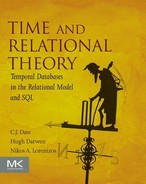Table of Contents
Part I: A Review of Relational Concepts
Part I A Review of Relational Concepts
Chapter 1. Types and Relations
Part II: Laying the Foundations
Part II Laying the Foundations
Chapter 4. Time and the Database
Valid Time vs. Transaction Time
Chapter 5. What’s the Problem?
Sample Constraints and Queries
Fully Temporalizing the Example
Chapter 8. The EXPAND and COLLAPSE Operators
Chapter 9. The PACK and UNPACK Operators I: The Single-Attribute Case
Chapter 10. The PACK and UNPACK Operators II: The Multiattribute Case
PACKING and UNPACKING on NO Attributes
UNPACKING ON Two or More Attributes
PACKING ON Two or More Attributes
Chapter 11. Generalizing the Algebraic Operators
Part III: Building on the Foundations
Part III Building on the Foundations
Chapter 12. Database Design I: Structure
Chapter 13. Database Design II : Keys and Related Constraints
Simplifying the Running Example
Neither PACKED ON nor WHEN / THEN
Chapter 14. Database Design III : General Constraints
During Relvars Only I: U_UPDATES
During Relvars Only II: Portion Specifications
During Relvars Only III: Multiple Assignment
Chapter 17. Logged Time and Stated Time
Appendix A. Cyclic Point Types
The Corresponding Interval Type
Appendix B. Is Ordinality Necessary?
Appendix C. Generalizing PACK and UNPACK
Effect on “PACK and UNPACK ON”
Appendix D. A Tutorial D Grammar
Appendix E. Implementation Considerations
